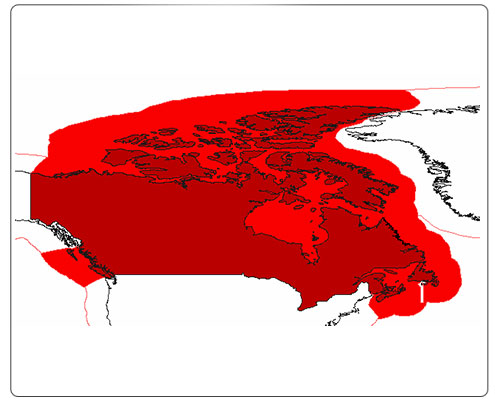WE’VE GOT YOU COVERED ANYWHERE IN CANADIAN WATERS!
Canada is a water-rich country. It is surrounded on three sides by the Atlantic, Pacific and Arctic oceans. We have over 243,000 km of coastline, the longest in the world. About 12% of our country’s surface area is covered by lakes and rivers[1].
From June 8 to 14, we celebrated Rivers to Oceans Week. This week recognizes how water is connected through watersheds. An oil spill from a ship or boat could have devastating effects on the aquatic ecosystems.
We can compensate following incidents happening anywhere in Canadian waters. But, what do we mean by that?
- Is it a body of water over which a ship or boat can travel?
- Is it part of either Canada’s internal waters, territorial sea, or exclusive economic zone (EEZ)?
If the answer to both questions is yes, then we can provide compensation. See the territory it represents in red below:

The type of waterways it happens in doesn’t matter. It can be, for example:
- Lake
- River
- Pond
- Spring
- Artificial waterway, such as a canal
- Estuary
- Fjord
- Bay
- Lagoon
- Wetland
- Open sea until the limit of the EEZ:
- By that, we mean up to 200 nautical miles from the shore.
What about incidents happening in international waters?
We can provide compensation if the damages are suffered in Canada.
Is compensation available if a water treatment plant is shut down to avoid or to clean up contamination?
The answer is yes. Many municipalities use a waterway for their safe and reliable source of water. If oil contaminates the water treatment plant, it may pose health risks and cause economic losses.
For example, when a local government shuts down a water treatment plant to prevent contamination, they could consider submitting a claim for costs incurred. The same could be done to repay the costs of repairing or replacing parts of the treatment plant, including soiled filters.
We can also compensate governments for the costs to inform the population about public safety concerns, such as:
- drinking water advisory,
- closures of contaminated beaches, and
- other preventive measures to mitigate the risks associated with the spill.
For more information on what we cover, watch our short video on our home page.
[1] Statistics Canada, Human Activity and the Environment, 2010, Catalogue No 16-201-X (Ottawa: Statistics Canada, 2010).
